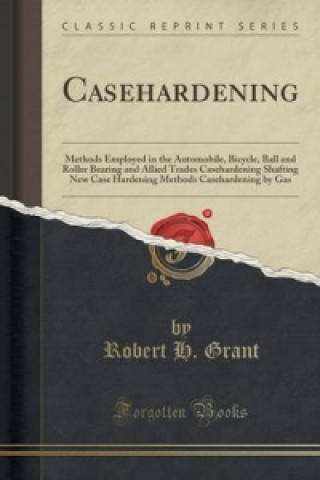
Kód: 09829599
Casehardening
Autor Robert H Grant
Excerpt from Casehardening: Methods Employed in the Automobile, Bicycle, Ball and Roller Bearing and Allied Trades Casehardening Shafting New Case Hardening Methods Casehardening by Gas Casehardening is the process of increasin ... celý popis
- Jazyk:
 Angličtina
Angličtina - Vazba: Brožovaná
- Počet stran: 62
Nakladatelství: Forgotten Books, 2015
- Více informací o knize

Mohlo by se vám také líbit
-

Dune
216 Kč -

Haunting Adeline
621 Kč -

Berserk Deluxe Volume 2
1092 Kč -

White Nights
89 Kč -

Powerless
268 Kč -

Atomic Habits
330 Kč -

Dune Messiah
228 Kč -

Berserk Deluxe Volume 3
1142 Kč -

One Day
221 Kč -

Berserk Deluxe Volume 1
1115 Kč -

Iron Flame
368 Kč -

Surrounded by Idiots
213 Kč -

Harry Potter and the Prisoner of Azkaban (Minalima Edition)
993 Kč -

Gravity Falls Journal 3
443 Kč -

Heaven Official's Blessing: Tian Guan Ci Fu (Novel) Vol. 1
420 Kč -

The Creative Act
568 Kč -

Dune
276 Kč -

Hunting Adeline
624 Kč -

A Little Life
290 Kč -

Children of Dune
230 Kč -

Heaven Official's Blessing: Tian Guan Ci Fu (Novel) Vol. 2
427 Kč
Informovat o naskladnění knihy
Zadejte do formuláře e-mailovou adresu a jakmile knihu naskladníme, zašleme vám o tom zprávu. Pohlídáme vše za vás.
Více informací o knize Casehardening
 Anotace knihy
Anotace knihy
Excerpt from Casehardening: Methods Employed in the Automobile, Bicycle, Ball and Roller Bearing and Allied Trades Casehardening Shafting New Case Hardening Methods Casehardening by Gas Casehardening is the process of increasing the carbon content of the surface of steel comparatively low in carbon, so that it can be hardened by the usual method of being heated to the hardening temperature and quenched in a cooling medium. The term casehardening, by itself, implies the hardening of the surface or skin of an article, and in order to fully understand the process and its object, it is necessary to briefly consider the facts and laws upon which it is founded. Carbon has a very great affinity for iron and combines with it at all temperatures above a faint red heat. Advantage was taken of this fact in the production of steel by cementation, an old process which consisted of rolling wrought iron into thin strips and then placing these in boxes with some material containing a fair proportion of carbon. These boxes were then heated to a very high temperature and the carbon was gradually absorbed by the iron. The process of casehardening is, in fact, only an improvement on this old cementation process used in times past for making steel from wrought iron. The steel is heated in packing boxes in the presence of a carbonaceous material and when the surface of the steel has absorbed enough carbon so that it will harden the same as high-carbon steel, it can be quenched in oil or water, according to the requirements. For many purposes, in machine work, articles are required which must have a perfectly hard surface and yet be of such internal structure that there is no chance of breaking them when in use. In many instances, this result can be obtained better by using casehardened mild steel than by using high-class crucible steel. For example, in making axles, cups, cones, and many similar parts for bicycles, it is extremely difficult to obtain perfect hardness combined with great resistance to torsional, shearing or bending stresses. For such purposes, nothing meets these requirements so well as do articles which have been casehardened. A great improvement has been made in casehardening processes during the last few years. The advance was begun with the development of the bicycle industry; and the necessity for casehardened parts of the highest quality in automobile manufacture has caused a still further improvement in this field. As an example of what has been accomplished by proper casehardening methods, consider the transmission gearing of an automobile. Who would think of throwing in the back-gears of a lathe or any other machine tool without first stopping the machine? In an automobile, however, this very thing is actually done dozens of times a day, by a person who gives little thought to what he is really doing. Yet the gears stand up under this treatment because of being manufactured of special steels developed during recent years and because of being heat-treated and casehardened by improved methods. About the Publisher Forgotten Books publishes hundreds of thousands of rare and classic books. Find more at www.forgottenbooks.com This book is a reproduction of an important historical work. Forgotten Books uses state-of-the-art technology to digitally reconstruct the work, preserving the original format whilst repairing imperfections present in the aged copy. In rare cases, an imperfection in the original, such as a blemish or missing page, may be replicated in our edition. We do, however, repair the vast majority of imperfections successfully; any imperfections that remain are intentionally left to preserve the state of such historical works.
 Parametry knihy
Parametry knihy
Zařazení knihy Knihy v angličtině Technology, engineering, agriculture Industrial chemistry & manufacturing technologies Metals technology / metallurgy
- Plný název: Casehardening
- Podnázev: Methods Employed in the Automobile, Bicycle, Ball and Roller Bearing and Allied Trades Casehardening Shafting New Case Hardening Methods Casehardening by Gas (Classic Reprint)
- Autor: Robert H Grant
- Jazyk:
 Angličtina
Angličtina - Vazba: Brožovaná
- Počet stran: 62
- EAN: 9781332235889
- ISBN: 9781332235889
- ID: 09829599
- Nakladatelství: Forgotten Books
- Hmotnost: 95 g
- Rozměry: 229 × 152 × 3 mm
- Datum vydání: 05. August 2015
Osobní odběr Praha, Brno a 12903 dalších
Copyright ©2008-24 nejlevnejsi-knihy.cz Všechna práva vyhrazenaSoukromíCookies



 Vrácení do měsíce
Vrácení do měsíce 571 999 099 (8-15.30h)
571 999 099 (8-15.30h)